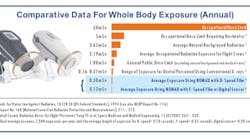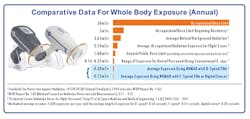Safety of x-ray units: Hygienist needs reassurance about handheld radiation devices
By Dianne Watterson, RDH, BS, MBA
Dear Dianne,
Recently, the doctor I work with purchased a new x-ray machine. I should be glad, because the unit I had been using was a real dinosaur, but I'm not convinced of the new unit's safety. This unit is not mounted on the wall or ceiling but is handheld.
When I questioned the safety of actually exposing x-rays while holding the machine in my hands, the doctor told me that my concerns were invalid. He said this machine is very safe and not to worry. I took radiology many years ago, so I know things have changed over time. But I'm used to standing at least six feet from the tube head behind a wall to avoid radiation. Now the doctor tells me it's OK to actually hold this thing right in front of my body and take x-rays. Sheesh! And he casually dismisses my questions as if I'm supposed to just accept his word as being right.
I'm scared every time I press the button! What if this gadget malfunctions and gives me cancer? What if it's not as safe as he says it is? Can you give me any reassurances?
Nervous Nellie, RDH
Dear Nervous Nellie,
I have volunteered in numerous Mission of Mercy clinics, and I work in whatever capacity they ask, including sterilization, assisting, and radiology. Last time, they put me in radiology, and the x-ray unit was a handheld device. I'll admit to my trepidation with this unit. Holding the machine close to my body and exposing x-rays gave me the jitters, but the doctor in charge of radiology assured me that it was perfectly safe. I was told that the shield mounted on the front of the unit would protect me from any radiation, scatter or otherwise.
Interestingly, in November 2014, an article appeared on Dr. Bicuspid that contained information about cheap, off-brand handheld units that are not FDA-approved. According to the article, "An influx of inexpensive options has emerged that sometimes lack the necessary safety measures. These devices fail to meet FDA standards but are advertised actively and sold online in the U.S."1 The article further stated, "Given the lower price compared with that of FDA-cleared devices, ill-informed dental care providers might purchase a device that is not FDA-cleared, unaware that they are putting themselves, their staff members, and their patients at great risk."
You did not mention the brand name of the unit the doctor purchased, but the one that has been thoroughly tested and FDA-approved is Nomad. Several versions have been introduced to the market including Nomad, Nomad eXaminer, and Nomad Pro 2.
Your question prompted me to contact the makers of the Nomad Pro 2 machine for some information. According to information on their website, the operator is protected by a six-foot-wide protection zone.
"Nomad Pro 2 employs an external backscatter shield that protects the operator from reflected radiation. This shield produces a cone-shaped protection zone extending behind it. At the position where the operator stands, the zone has a diameter of more than six feet, enough to protect the operator's entire body. In addition, radiation shielding inside Nomad Pro 2 ensures that leakage from the x-ray source itself is virtually eliminated, protecting the operator's hands and other areas close to the device."2
I believe there are some benefits to be gained from using a handheld x-ray device. First, positioning is easier with a lightweight, handheld unit when compared with bulky wall- or ceiling-mounted units. Second, the patient should be less intimidated about x-rays if the operator can stand right in the same room as opposed to the operator dashing out to stand behind a wall or screen. Third, the images I've seen with the handheld unit are superior to images produced by older x-ray units. Fourth, traditional x-ray units take up a lot of space, whereas the handheld unit is much smaller and less obtrusive in the operatory. One unit can service up to four operatories. As far as I know, the only real disadvantage of a handheld x-ray unit is the potential damage to the unit if it is dropped. Accidents happen, as we all know.
The way that staff members receive new technology is often related to how it is presented to them. Doctors who use the "don't-ask-just-do-as-I-say" technique are likely to see resistance from staff members. If a doctor decides to implement a handheld x-ray device, there should be a staff meeting for the doctor to review safety data and help staff members understand that the technology is not only safe but also has many benefits. Evidently, the doctor you work with did not take time to help you and your coworkers understand this technology before thrusting it on the team.
Every dental professional who exposes radiographs has to receive the necessary professional training to understand how to properly expose radiographs as well as be aware of the dangers inherent with radiation. The good news is that handheld technology, for those units that have received FDA clearance, has greatly improved the safety of x-ray units-both for operators and patients.
It is every employer's responsibility to provide a safe working environment for staff members, and you have every right to ask questions related to safety issues. If the x-ray unit is a Nomad Pro 2 (the latest one on the market), you can feel confident it is safe. If the unit is an off-brand unit manufactured in China or Korea, there may be safety issues related to radiation leakage. In that case, it would be advisable to contact your local state dental board and find out how to contact the office of radiation safety in your state. Their representative could conduct some tests to determine if the unit in your dental practice is safe to use.
All the best,
DIANNE
References
1. Mughal R. Study warns against using unsafe handheld x-ray devices. DrBicuspid.com. http://www.drbicuspid.com/index.aspx?sec=ser&sub=def&pag=dis&ItemID=316764. Published November 12, 2014. Accessed November 14, 2016.
2. Nomad Product Safety. Aribex Inc. http://aribex.com/portable-x-ray-machine/safety/. Accessed November 14, 2016.
DIANNE GLASSCOE WATTERSON, RDH, BS, MBA, is an award-winning speaker, author, and consultant. She has published hundreds of articles, numerous textbook chapters, an instructional video on instrument sharpening, and two books. For information about upcoming speaking engagements or products, visit her website at www.wattersonspeaks.com. Dianne may be contacted at (336)472-3515 or by email [email protected].







